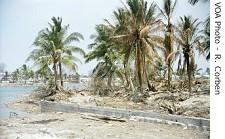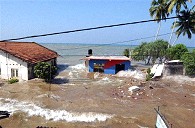voa标准英语2008年-Australia Sets Up New Tsunami Warning System(在线收听)
The Australian tsunami warning system is part of what officials hope will be a network of centers across the Indian Ocean that share scientific data.
Indonesia, which was badly hit by the Indian Ocean tsunami four years ago, is expected to have its own early warning mechanism working by the end of the year.
 |
| Baan Nam Khem, Khao Lak Phang Nga Province, Southern Thailand - hardest hit from Dec 26 tsunami |
The Australian project is based in the southern city of Melbourne and relies on high technology deep sea buoys. Five are in waters northwest of Australia, while others are off the continent's east coast in the Coral Sea. Additional buoys are further south in the Tasman Sea.
Barry Drummond from the government's Geoscience office says the new system will provide accurate information about the risks of giant waves.
"Rather than saying a tsunami is on its way and it may impact the coastline of whichever state, the center is now in a position to be able to say, along that coastline these areas are more susceptible than those and in these areas the threat will be to things in the water; swimmers, boats, harbors and that sort of things and within these other areas the tsunami may come ashore and then these are the areas that you have to worry about," explained Drummond. "So far more detail. It allows us not to over-warn and ensures we don't under-warn."
The sensitive monitoring equipment allows scientists to pinpoint the location of an earthquake that could trigger a tsunami, its depth and strength.
 |
| Tidal waves wash through houses at Maddampegama, about 60 kilometers south of Colombo, Sri Lanka |
The Australian system also will provide sea level and seismic data to vulnerable island nations in the Pacific Ocean and also to authorities in Japan.
The epicenter of the undersea earthquake that triggered the December 26, 2004, Indian Ocean tsunami occurred off the west coast of Sumatra in Indonesia.
More than 200,000 people were killed in 11 countries. Many coastal areas were swamped by waves up to 30 meters high.
It was one of the world's worst natural disasters. Indonesia, Thailand, India and Sri Lanka were hardest hit.
Unlike the Pacific, the Indian Ocean did not have a system to warn coastal communities that a tsunami was on the way.
In the aftermath of the 2004 disaster, scientists and governments began working on an alert network for the Indian Ocean region.